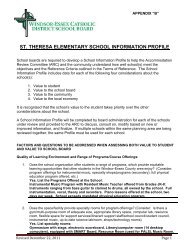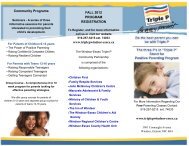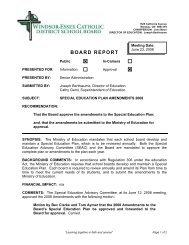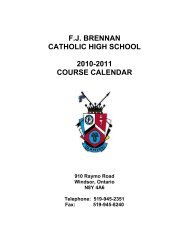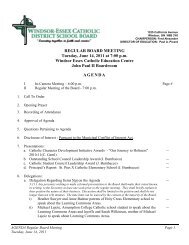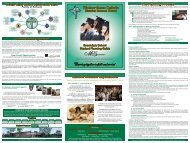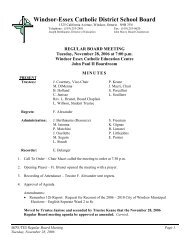ST: 11A Anaphylaxis Policy - Windsor-Essex Catholic District School ...
ST: 11A Anaphylaxis Policy - Windsor-Essex Catholic District School ...
ST: 11A Anaphylaxis Policy - Windsor-Essex Catholic District School ...
You also want an ePaper? Increase the reach of your titles
YUMPU automatically turns print PDFs into web optimized ePapers that Google loves.
<strong>Windsor</strong>-<strong>Essex</strong> <strong>Catholic</strong> <strong>District</strong> <strong>School</strong> Board NUMBER: <strong>ST</strong>: <strong>11A</strong>Section: StudentsEFFECTIVE: June 12, 2007AMENDED: April 26, 2011POLICY <strong>ST</strong>: <strong>11A</strong><strong>Anaphylaxis</strong> <strong>Policy</strong>RELATED POLICIES:REPEALS:See ReferencesREVIEW DATE: 2014 - 20151.0 OBJECTIVE:1.1 In keeping with the <strong>Windsor</strong>-<strong>Essex</strong> <strong>Catholic</strong> <strong>District</strong> <strong>School</strong> Board’s (the Board’s) missionof providing a safe and nurturing learning environment, the Board wishes to adopt apolicy, which creates allergen-aware environments in its schools. The Board will adoptpolicy and procedure that will assist in protecting students who have potentially lifethreatening allergies.2.0 DEFINITIONS:2.1 <strong>Anaphylaxis</strong> – means a severe systemic allergic reaction, which can be fatal, resulting incirculatory collapse or shock and “anaphylactic” has a corresponding meaning. Sabrina’sLaw, 2005, S.O.,c. 7,s.1.2.2 Epinephrine Auto-Injectors - for the purposes of clarification, one dose epinephrine autoinjectors,for example the EpiPen® or EpiPen Jr.®, and the first dose of a two doseepinephrine auto-injector, for example the Twinject®, are acceptable. Employees of theBoard do not administer the second dose (needle) of the two dose epinephrine autoinjector.3.0 GUIDING PRINCIPLES:3.1 The <strong>Anaphylaxis</strong> <strong>Policy</strong> and Procedure are intended to reduce the risk of exposure toallergens and to ensure school staff and others in contact with students who have ananaphylactic allergy are prepared to handle an emergency situation.Neither the Board nor the school can be expected to create an allergen-free environment,but they are, with the cooperation of parents/guardians, responsible for reducing risk, andhaving a plan in place that allows the school community to react appropriately when anemergency occurs.3.2 This <strong>Policy</strong> shall be administered in conjunction with the objectives and guiding principlesof A:14 Promoting and Supporting Equity & Inclusion Within a <strong>Catholic</strong> Community.<strong>Policy</strong> Manual Page 1 of 3
POLICY <strong>ST</strong>: <strong>11A</strong> <strong>Anaphylaxis</strong> <strong>Policy</strong>4.0 SPECIFIC DIRECTIVES:4.1 The Director of Education will develop procedures to meet this policy’s objectives thatinclude the following:a) Strategies that reduce the risk of exposure to anaphylactic causative agents inclassrooms and common school areas.b) A communication plan for the dissemination of information on life-threateningallergies to parents, students and employees as may be directed throughAdministrative Procedure.c) Annual training on dealing with life-threatening allergies for all employees andothers who are in direct contact with students on a regular basis.d) A requirement that every school principal develop an individual plan for eachstudent who has an anaphylactic allergy.e) A requirement that every school principal ensure that, upon registration, parents,guardians and students shall be asked to supply information on life-threateningallergies.f) A requirement that every school principal maintain a file for each student having ananaphylactic allergy of current treatment and other information, including a copy ofany prescriptions and instructions from the student’s physician or nurse and acurrent emergency contact list.4.2 An individual plan for a student with an anaphylactic allergy shall be consistent with theBoard’s policy and shall include:a) Details informing employees and others who are in direct contact with the studenton a regular basis of the type of allergy, monitoring and avoidance strategies andappropriate treatment.b) A readily accessible emergency procedure for the student, including emergencycontact information.c) Storage for epinephrine auto-injectors, where necessary.4.3 Employees of the Board may be preauthorized to administer medication or supervise astudent while he or she takes medication in response to an anaphylactic reaction (providedthe student is able to self-administer and understanding that often a student suffering froman anaphylactic reaction will not have the ability to self-administer), provided the schoolhas treatment information that is updated at least once yearly and the consent of the parent,guardian, or student, as applicable.4.4 It is the obligation of the student’s parent or guardian and the pupil to ensure that theinformation in the pupil’s file is kept up-to-date with the medication that the student istaking.4.5 If an employee has reason to believe that a student is experiencing an anaphylacticreaction, the employee may administer an epinephrine auto-injector or other medicationprescribed to the student for the treatment of an anaphylactic reaction, even if there is nopreauthorization to do so.<strong>Windsor</strong>-<strong>Essex</strong> <strong>Catholic</strong> <strong>District</strong> <strong>School</strong> Board Page 2 of 3
POLICY <strong>ST</strong>: <strong>11A</strong> <strong>Anaphylaxis</strong> <strong>Policy</strong>5.0 RESPONSIBILITY:5.1 All Board employees and others in regular contact with students should be familiar withthe <strong>School</strong> Board’s <strong>Anaphylaxis</strong> <strong>Policy</strong> and Procedure and abide by their provisions.5.2 Students who have an anaphylactic allergy and parents/guardians are responsible forensuring the information in the student’s file is updated at least once yearly.5.3 Students and parents/guardians in the school community are asked to cooperate in abidingby the Board’s policies and procedures as well as the school’s anaphylactic plan.6.0 REVIEW AND EVALUATION:6.1 The effectiveness of this policy shall be assessed through trustee, staff and communitysatisfaction measures.6.2 The policy will be reviewed during the 2014 - 2015 policy review cycle.7.0 REFERENCES:Sabrina’s Law, 2005Municipal Freedom of Information and Protection of Privacy ActOntario Student Record (OSR) GuidelinesMinistry of Education PPM 81 Provision of Health Support Services in <strong>School</strong> Settings<strong>Anaphylaxis</strong>: A Handbook for <strong>School</strong> Boards - Canadian <strong>School</strong> Boards Association, 2001<strong>Anaphylaxis</strong> in <strong>School</strong>s and other settings © 2005, 2009Canadian Society of Allergy and Clinical ImmunologyProcedure <strong>ST</strong>:<strong>11A</strong> <strong>Anaphylaxis</strong> Procedure (Including Administration of Emergency Medication)<strong>Policy</strong> <strong>ST</strong>:11 Student Health Support (Including Medication Administration at <strong>School</strong>)Procedure <strong>ST</strong>:11 Student Health Support (Including Medication Administration at <strong>School</strong>)<strong>Policy</strong> A:14 Promoting and Supporting Equity & Inclusion Within a <strong>Catholic</strong> Community<strong>Policy</strong> A:30 PrivacyProcedure PR H:06A Procedure for the Disposal of Sharps<strong>Policy</strong> SC:04 Field Trips<strong>Policy</strong> SC:13 Release of Student Information<strong>Policy</strong> <strong>ST</strong>: 15 Accidents/Students<strong>Policy</strong> <strong>ST</strong>:20 Collection of Personal Information<strong>Windsor</strong>-<strong>Essex</strong> <strong>Catholic</strong> <strong>District</strong> <strong>School</strong> Board Page 3 of 3



